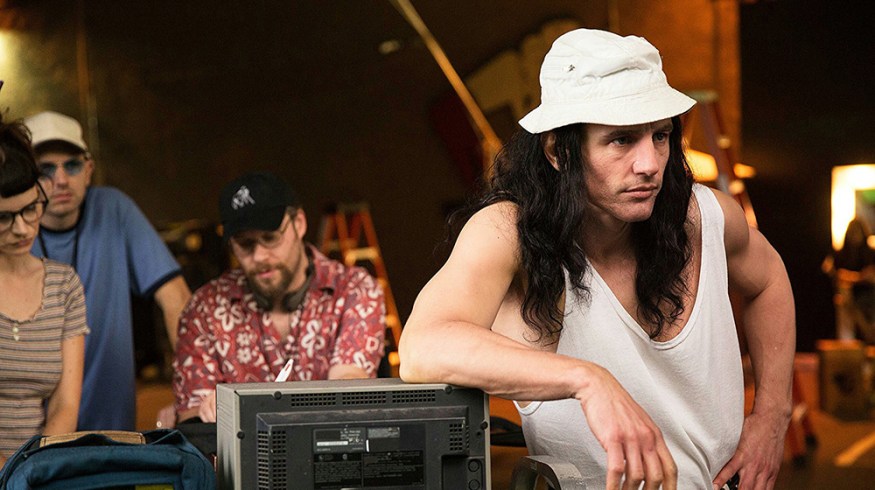
The Disaster Artist: Editing A Film About Making a Film
We talked with the editor of The Disaster Artist about what it’s like telling a true story that is simultaneously hilarious, inspiring, and bizarre.
All images via A24.
One of the strangest cultural phenomena to come out of the 21st century is the cult god Tommy Wiseau. The story of how the “worst movie ever made” found its fanbase among cinephiles defies all logic, but here we are with an award-winning movie about the making of The Room.
After talking with the editor of The Disaster Artist, I learned that one of the most fascinating aspects of the film’s story is its reception. Even before the movie debuted, there were expectations the team was fighting to meet. On one hand, you have the die-hard fans of The Room who know the source material by heart and want to see it honored and respected. On the other hand, you have the mainstream audience who might not know anything about the legendary film. The production team met the challenge head-on, and the editor, Stacey Schroeder, was a big part of telling the story in a respectable way that honored the source material while entertaining audiences.
Portraying Tommy Wiseau
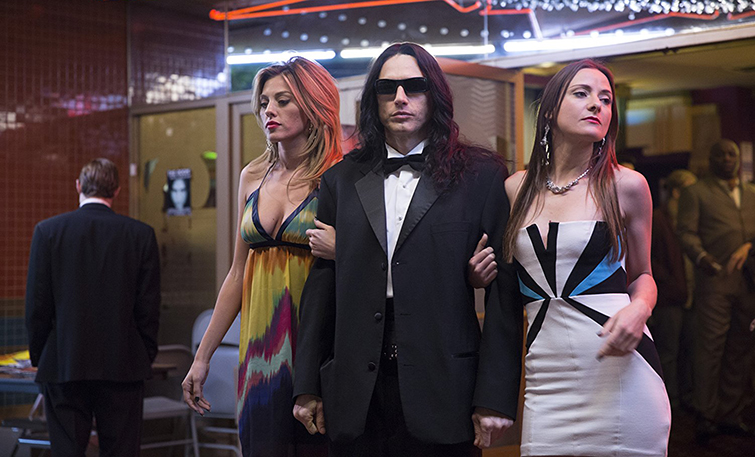
One of the most admirable accomplishments of the film is that it nails Tommy Wiseau’s redeeming qualities. For being such a divisive figure in the filmmaking community, he comes across as a sympathetic-yet-ambitiously flawed character. However, this was no easy feat. Schroeder and the team behind the film were careful to balance comedy, drama, and cringe:
We didn’t want to make fun of Tommy ever — we constantly discussed the balance of being true to that story, which is very complicated, and sometimes a little nonsensical, and then not making fun of him. We wanted to make sure that we were making him relatable on some level by helping the audience understand his motives. This idea of having a dream and pursuing it, [with] whatever means are available to you, is very universal. We knew if we could push that narrative, people could relate to the story and the character of Tommy. To relate to Tommy, you don’t have to believe you would make all the same decisions as him — you just have to understand why he made the decisions he did. That idea of desire and wanting respect and wanting to be liked on some level are all universal themes that carry the movie.
The film successfully makes a questionable, sometimes-rude character likable — a character that has gained a massive following since The Room‘s initial release in 2003. Like any piece of pop-culture with a substantial following, bringing the characters to the screen came with challenges.
It was tough, though, because he is such a character and is known to a lot of people. The Room has a lot of fans built in that bring something to that movie when they watch it, and they expect something from that character, so it was tricky.
However, reception from fans everywhere has been nothing but positive for the film’s strong narrative and comedic qualities.
The Film’s Initial Reception

The premiere at the 2017 SXSW Film Festival in Austin, Texas, was the first chance Tommy Wiseau got to see the film — along with several hundred other people. So, for a movie about someone making one of the worst movies ever, it’s hard not to go into the theater thinking about the titular character in a comedic and (frankly) insulting way. Schroeder and company, however, were confident that the story wouldn’t upset Wiseau:
I don’t think we’re ever condescending to Tommy or Greg in the movie. I think the idea that they make a bad movie wasn’t treated as a joke — more like the result of this desperation they had. They wanted so badly to be accepted into Hollywood. Tommy just wants to be liked, and they didn’t have the proper tools to necessarily get to where they wanted to be, so they just went at it alone, and on some levels, that’s just really admirable. The whole story is a take on perspective. Just because the outcome isn’t exactly how you planned it, does that make something not a success? The Room is considered a lot of people’s favorite movie.
The filmmakers described the version they showed at the initial screening as a work in progress. The premiere would be a moment of truth for Schroeder and crew, eager to see how Tommy (and the general public) would react. Knowing that most of the audience at SXSW would probably know of or have some appreciation for The Room helped, but they still didn’t know what to expect. After the viewing, they got both critical praise and appreciation from the audience. After this screening, Schroeder and her team made a few changes to the 90-minute, film including some additional titles and a few new cuts:
He didn’t see the movie until SXSW . . . all the filmmakers were there; we were all holding our breath a little bit because we didn’t know what he would think of it. But it was a tough film to test on people who didn’t know what they were walking into. So going into SXSW, we knew the audience was probably going to be primed for this type of film, specifically familiar with The Room and with Tommy. So we were pretty confident in the cut, but we had some room to make some tweaks after SXSW, and it did go really well, and people responded positively to the film. The changes we made afterward were really minor.
Exposition for a New Audience
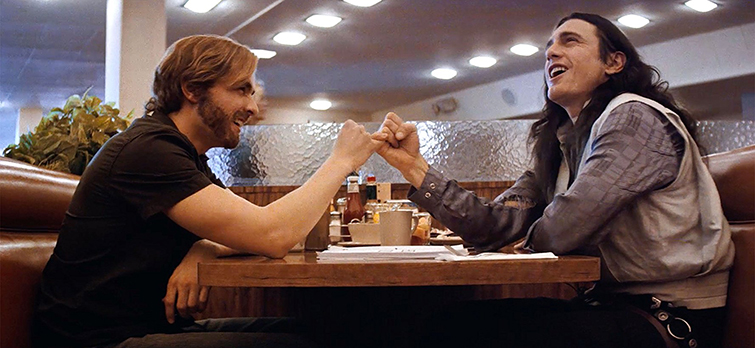
If you haven’t seen the film, the first sequence you see is a series of interviews with big-name celebrities talking about the first time they saw The Room. It’s a short, sweet, somewhat-humorous way to prep the audience for the story they are about to watch. But, the sequence is a masterful example of how to balance real life with a fictional world.
It was very important to all of us that it wasn’t just a movie for fans of The Room. There’s a lot of them, but we wanted to make sure it worked for people who hadn’t seen the original source material. We just wanted to make sure that, from the beginning, people understand that this was a real thing that exists without just dropping them into this character who seems so crazy — because Franco’s performance is very accurate. There were two different scenes at the beginning of the movie, then we shifted to title cards that established that ‘This is a true story.’ We were getting some comments that people were still unsure about what they just watched and if it was really based on a true story. But, eventually, we went with the interviews because some of these people were so great about talking about their experience with The Room.
Sources of Inspiration
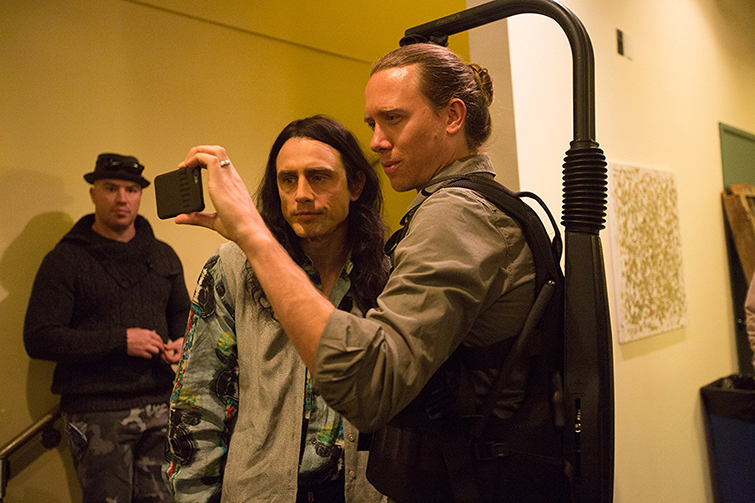
One of the most interesting aspects of The Disaster Artist is how the filmmakers shot it. The camera moves in and out of fake movie scenes and setups, so at some points, you’re not sure if you’re watching the film-within-the-film or the film you bought a ticket to see. It’s a wonderful blend of documentary-style shots and dialogue. Schroeder discussed the cutting of some of the long-take shots:
They do a lot for those tracking shots behind Tommy. He’s kind of this larger-than-life, looming figure. Especially at the beginning when the camera follows Tommy onto the stage as we see him for the first time. (The Wrestler influences are very prominent in that shot.) Brandon shot a lot of handheld footage, which gives it that documentary feel. The handheld stuff can be tricky to cut because when cameras are moving, sometimes it’s hard to get in and out of shots, and once they get going into the recreation of The Room, the takes start lasting longer.
In order to build tension, Schroeder decided not to cut certain scenes in the film. She wanted the audience immersed in the extremely tense and awkward moment while Tommy and Greg, or Tommy and the crew, argue about what’s going wrong with production.
The scene when Tommy and Greg are on the roof and he keeps having the weird laughing reaction to a moment when he shouldn’t. We stayed in a oner because it just starts to feel more stressful, and we wanted the audience to have that feeling as well.
This is filmmaking at its finest. The DP shoots a scene one way, then the editor determines what makes the most sense for the emotional weight of the story in this moment and lets it play out. This scene, in particular, is so awkward and hilarious that you simultaneously want it to end and keep going. What a story, Stacey, ahah.
Editing Improv
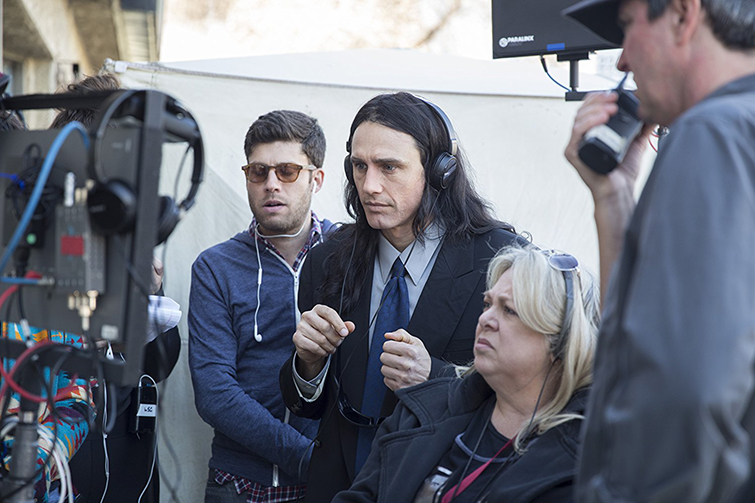
As you might expect in a movie filled with comedic actors, Schroeder and her team had to sift through plenty of improvisation. As an editor (especially cutting Franco, Rogen and Goldberg), you’re going to have to find the jokes that really land, while still telling your story.
We, certainly in the edit room, try out a lot of jokes. When I’m receiving dailies, I try to cut my favorite version of most of the jokes that come through — just to have them cut together, and it can give you a different feel. Then I try to pick my favorites and put them in my editor’s cut. The jokes in this one, though, were tough. We took out really funny jokes in moments when we needed people not to laugh — or when it felt just too broad, or too out of character, or out of the scene. There’s so much emotion in this movie, more than the average comedy, we had to be very careful picking the moments. There was a lot of discussion, and things came in and out a lot (clips being cut and brought back in), but you get there.
So, naturally, I asked her which of the darlings she killed was her favorite:
One of the original openings to the movie (hopefully this will end up on the extra material so people can see it) started with Greg alone in his bedroom before he moved to Los Angeles with Tommy, acting out his favorite scenes from Point Break into a little camcorder. Just for the tone and pace of the movie, it was the right thing to do.
Mockumentary vs. True Story
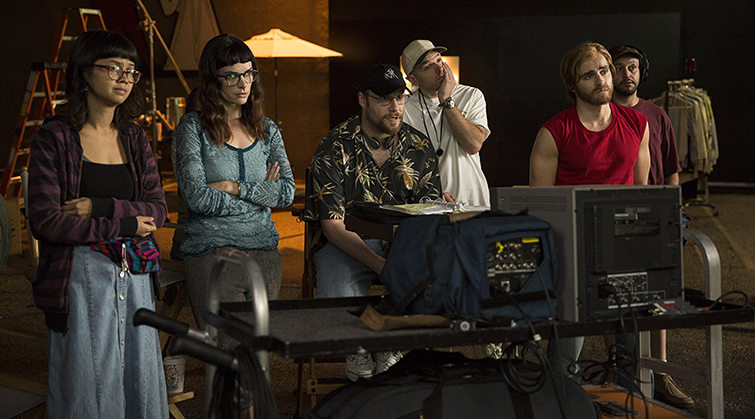
Having worked on projects like Popstar: Never Stop Never Stopping, Schroeder found that the footage and editing flow of this project couldn’t have been more different. Instead of endless talking heads or short bits, she had long, emotionally weighted scenes that had to hit very specific notes.
Everything is kind of its own problem in some way. The great and overwhelming thing about Popstar is that we changed so much of it in the edit. We could just have Andy do another talking head on a whim or do ADR and cut together concert footage and change the story, so it was much more malleable in that way. You could really change the narrative with that movie as much as we needed to. With this one, you couldn’t do it as much for a couple reasons. First, it is more narrative, and it’s a real story with humans who have lived it who are out there, even though they are not super famous — they are public figures, and Greg had written a book about it, so the story already existed. But, that being said, their story is so incredibly complicated that, to tell it, there were a lot of scenes that were cut simply for clarity. The real story is a little more fragmented in a way that we didn’t need.
On which film was harder to edit for which reasons, Schroeder had the following to say:
The pace was harder on Popstar, but the tone was harder on The Disaster Artist. The tone on this one was probably one of the things we had the most conversations about, and I feel it is one of the biggest strengths of the movie. It’s such a razor-sharp edge of making jokes, making fun, and relating to the characters.
Advice for New Editors
Just get in there and do the work, or if you love editing (or whatever bit of filmmaking it is that really interests you), keep doing it and keep doing it — over and over. If it interests you, then it is resonating with you, and you might not be amazing at it when you sit down to do it for the first time. It might not turn out how you wish it had. But all of this is craft, and you have to work on it and hone it, so just take those jobs, do the shorts. It’s a collaborative medium, and you have to work with other people. The more work you take on, and the more filmmakers you work with and build relationships with, the easier your path will become, and the whole career will become a little more fun because you develop these relationships, and you have an understanding with people.
There you have it: keep working and explore your passions.
This movie was edited on Avid Media Composer 8.1.
Looking for more filmmaking interviews? Check out our previous coverage.
- Interview: The Director and The Producer Behind “Man on Fire”
- Exclusive: Designing Wakanda and the Amazing Sets of Black Panther
- Interview: How the Editor Behind I, Tonya Recreated History
- Interview: How This Oscar Nom Edited Downsizing While Directing His First Feature
- Exclusive Interview: The Secrets Behind RED Sensors and Resolution
Interested in more articles on editing? Check these out.
- The Comprehensive Guide To Building Your Own Video Editing PC
- 5 Essential Tips for Editing Professional Interview Soundbites
- Resolve 14’s Best Editing Features For The Online Content Creator
- Editing Theory: How to Manipulate The Passage of Time
- How David Fincher Shot and Edited Netflix’s “Mindhunter”





